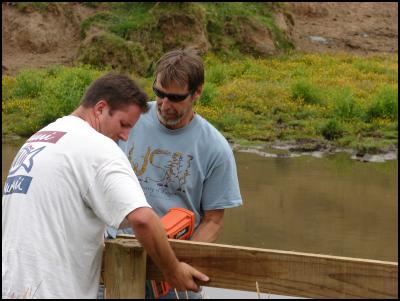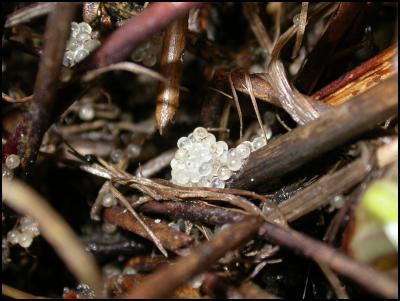Keeping whitebait from frittering away
August 14 2008
Keeping whitebait from frittering away

Click for big versionDr Mike Hickford (left) and Professor David Schiel installing livestock exclusion plots at Goughs Bay, Banks Peninsula.
With the whitebait season about to start, scientists from the University of Canterbury are engaged in timely research they believe will lead to better stocks of the delicacy in our streams and rivers.
Funded by $1.1 million from the Foundation for Research, Science and Technology, the researchers are working on a four-year project to investigate where our most common whitebait (inanga, or Galaxias maculates) lay their eggs and the issues that threaten their spawning habitats.
Foundation business manager Dr Barbara Brown says the research will help New Zealand better manage the resource for future generations.
“This project is providing knowledge of critical ecological pathways for these native fish, identifying threats to these pathways and reducing them,” she said. “It will lead to sustainable management of whitebait and their habitats by taking into account their entire life history requirements.”
The researchers have already discovered that whitebait favour very specific sites for spawning, with dense riverbank vegetation and high humidity conditions that are increasingly difficult to find along the banks of many of the West Coast and Canterbury waterways being studied.
“We knew that they laid their eggs amongst bank vegetation in the tidal areas of streams, but it’s much more specific than that,” says Dr Mike Hickford, one of the researchers.
“What’s important is what is happening underneath the vegetation. The inanga spawn where grasses clump together and form a dense root mat and where there is almost 100 per cent humidity, conditions that are as close to being under water as you can get out of the water. It’s not uncommon for different generations of fish to choose the same clump of grass for egg laying.”
The vegetation provides protection for the eggs which are laid on riverbanks on autumn high tides and stay there until the next high tide when the larvae hatch and are washed down the river and out to sea. They remain in the ocean over winter, returning to freshwater locations in spring, when whitebaiters are ready with their nets for them.
The whitebait season starts in most of New Zealand this Friday, August 15 and runs until November 30. On the West Coast the season is from September 1 to November 14 and on the Chatham Islands from December 1 till the end of February.
It is estimated that over 99.5 per cent of the larvae die between hatching and returning from the sea as whitebait, highlighting the importance of ensuring plentiful spawning sites if populations are to be sustained.
Dr Hickford says it can take years for optimum spawning conditions to develop and several factors work against the process and threaten existing spawning habitat, including flooding, sedimentation, grazing livestock, bank disturbance and deforestation.
Large rivers, such as the Buller on the West Coast, are often popular whitebaiting spots but they actually have very small spawning areas because the desirable habitat has been destroyed through flood control measures and the impact of urbanisation, Dr Hickford says.
“By and large it is probably smaller streams that are more vital for the health of the population as their spawning habitat tends to be more intact.”
Dr Hickford’s family comes from the West Coast and he has gone whitebaiting since he was a youngster, sparking his interest in learning why stocks of the highly valued species are depleted. While there are few historical records detailing the catch of whitebait, he says there is widespread belief that whitebait numbers are falling.
The research is being done by the Marine Ecology Research Group at Canterbury University, headed by Professor David Schiel with input from NIWA and the University of California, where Dr Hickford spent three years on a fellowship funded by the Foundation for Research, Science and Technology.
Professor Schiel says researchers are also trying to establish how many ideal spawning sites are needed to protect and grow whitebait stocks.

“Fish will spawn when they need to – they make do with the habitat they find. But many eggs are undoubtedly lost and therefore unable to contribute to future generations because optimum spawning conditions are hard to find.”
Another strand of the research involves using techniques developed at the University of California to determine important spawning sites, by detecting and analysing chemical traces in the otoliths (ear bones) of whitebait and tracing those to the river or stream where the larvae hatched.
The research findings have led to several initiatives designed to improve whitebait spawning habitats. The team is experimenting with enclosing trial areas on river and stream banks on the West Coast and in Canterbury to see if they can fast track the process of establishing optimum spawning conditions.
In other experiments, river banks have been modified, grazing stock removed and grass left to grow rather than being mowed to help re-establish natural conditions. It’s hoped larger scale initiatives, such as fencing off whole streams known to be important whitebait spawning areas, will be tried in the future.
The researchers are working with local authorities, environmental agencies and the Department of Conservation in both regions.
“A lot of people feel very
passionate about whitebait and what is happening to the
fishery,” says Dr Hickford. “By presenting the
underpinning science and developing robust models for
mitigation and remediation measures that will produce
results, we can make a difference.”
Website: www.frst.govt.nz
ENDS


 Citizens of the Sea: Sailors To Revolutionise Our Understanding Of Pacific Biodiversity
Citizens of the Sea: Sailors To Revolutionise Our Understanding Of Pacific Biodiversity Netsafe: Making A Splash With Online Safety: Netsafe Launches New Flagship Programme For Kids
Netsafe: Making A Splash With Online Safety: Netsafe Launches New Flagship Programme For Kids NZGBC: Flood Resilience PhD Student Widi Auliagisni Named Future Thinker Of The Year 2024
NZGBC: Flood Resilience PhD Student Widi Auliagisni Named Future Thinker Of The Year 2024 Business Canterbury: European Free Trade Agreement A Game-changer For Canterbury
Business Canterbury: European Free Trade Agreement A Game-changer For Canterbury Business Canterbury: Urges Council To Cut Costs, Not Ambition For City
Business Canterbury: Urges Council To Cut Costs, Not Ambition For City Wellington Airport: On Track For Net Zero Emissions By 2028
Wellington Airport: On Track For Net Zero Emissions By 2028



